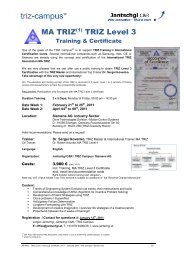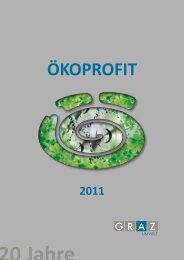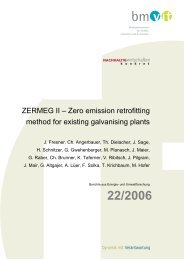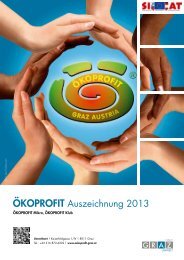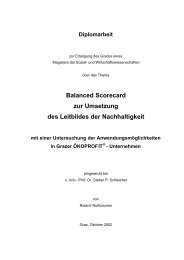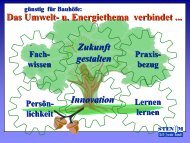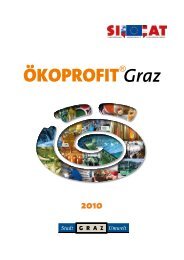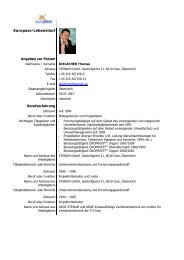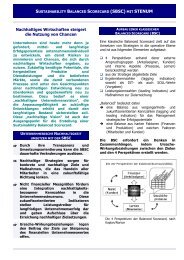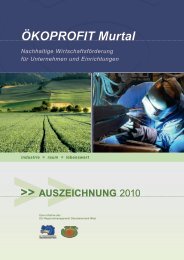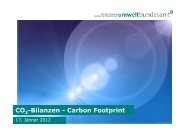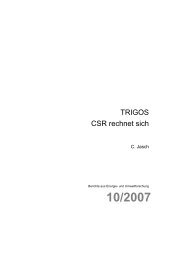Promoting Resource Efficiency in Small & Medium size ... - UNEP
Promoting Resource Efficiency in Small & Medium size ... - UNEP
Promoting Resource Efficiency in Small & Medium size ... - UNEP
You also want an ePaper? Increase the reach of your titles
YUMPU automatically turns print PDFs into web optimized ePapers that Google loves.
9.4 Benchmarks for food and beverage<br />
Table 33 gives benchmarks for the water consumption and wastewater<br />
generation for different subsectors of food process<strong>in</strong>g.<br />
Sector Water consumption Waste water volume<br />
Meat and poultry 2 – 20 m³/t 10 – 25 m³/t<br />
Fish<br />
Herr<strong>in</strong>g fillet<strong>in</strong>g<br />
Mackerel<br />
White fish<br />
Shrimp process<strong>in</strong>g<br />
Fruit and<br />
vegetable 1)<br />
Canned fruit<br />
Fruit juices<br />
Canned vegetables<br />
Frozen vegetables<br />
Deep frozen vegetables<br />
Preserved vegetables<br />
Potato<br />
Jams<br />
Baby food<br />
3.3 – 10 m³/t<br />
20 – 32 m³/t<br />
4.8 – 9.8 m³/t<br />
23 – 32 m³/t<br />
2.5 – 4.0 ³/t<br />
6.5 m³/t<br />
3.5 – 6.0 m³/t<br />
5.0 – 8.5 m³/t<br />
2.5 – 5.0 m³/t<br />
5.9 – 11 m³/t<br />
2.4 – 9.0 m³/t<br />
6 m³/t<br />
6.0 – 9.0 m³/t<br />
2 – 40 m³/t<br />
11 – 23 m³/t<br />
Starch<br />
Maize 1.7 – 3 m³/t 1.4 m³/t<br />
Wheat 1.7 – 2.5 m³/t 1.8 m³/t<br />
Potato 0.7 – 1.5 m³/t 2 m³/t<br />
Dairy 2)<br />
1 – 5 l/kg<br />
Milk and yoghurt 0.6 – 4.1 l/l<br />
Cheese<br />
1.2 – 3.8 l/l<br />
Milk powder, cheese<br />
and/or liquid products<br />
0.69 – 6.3 l/l<br />
Milk and yoghurt 0.8 – 25 m³/t 0.9 – 25 m³/t<br />
Cheese 1 – 60 m³/t 0.7 – 60 m³/t<br />
Milk powder, cheese<br />
and/or liquid products<br />
1.2 – 60 m³/t<br />
0.4 – 60 m³/t<br />
Beer 0.32 – 1 m³/hl 0.24 – 0.9 m³/hl<br />
Sugar beet<br />
0.233) – 1.5 m³/t<br />
Vegetable oil<br />
Crude oil production 0.2 – 14 m³/t 0.2 – 14 m³/t<br />
Chemical<br />
1 – 1.5 m³/t<br />
neutralisation<br />
1 – 1.5 m³/t<br />
Deodorisation 10 – 30 m³/t 10 – 30 m³/t<br />
Harden<strong>in</strong>g<br />
2.2 – 7 m³/t<br />
Chemical ref<strong>in</strong><strong>in</strong>g 0.25 – 0.8 m³/t 14 – 35 m³/t<br />
Olive oil production 5 m³/t<br />
Traditional extraction<br />
2 – 5 m³/t<br />
Three-phase extraction<br />
6 – 8 m³/t<br />
Two-phase extraction<br />
0.33 – 0.35 m³/t<br />
Soft and alcoholic 6 – 14 m³/m³<br />
dr<strong>in</strong>ks<br />
0.8 – 3.6 m³/m³<br />
Table 33: Positions where energy sav<strong>in</strong>gs could be made and their effect<br />
Table 34 to Table 40 show bestpractice material and energy balances to<br />
process 1000 kg of iced fish for the de-ic<strong>in</strong>g and wash<strong>in</strong>g, grad<strong>in</strong>g, descal<strong>in</strong>g,<br />
sk<strong>in</strong>n<strong>in</strong>g, fillet<strong>in</strong>g, sauce fill<strong>in</strong>g, cann<strong>in</strong>g, can wash<strong>in</strong>g.<br />
Inputs<br />
Outputs<br />
Ice and fish 1000 kg Fish 980 – 1000 kg<br />
Water 1 m³ Waste water 1 m³<br />
Electricity 0.8 – 1.2 kWh COD 0.7 – 4.9 kg<br />
Solid waste<br />
Table 34: Input and output data for de-ic<strong>in</strong>g and wash<strong>in</strong>g<br />
Inputs<br />
Outputs<br />
0 – 20 kg<br />
Fish 1000 kg Graded fish 980 – 1000 kg<br />
Water 0.3 – 0.4 m³ Waste water 0.3 – 0.4 m³<br />
Electricity 0.1 – 0.3 kWh COD 0.4 – 1.7 kg<br />
Solid waste<br />
Table 35: Input and output data for grad<strong>in</strong>g fish<br />
Inputs<br />
Outputs<br />
0 – 20 kg<br />
Fish with scales 1000 kg Scaled fish 960 – 980 kg<br />
Water 10 – 15 m³ Waste water 10 – 15 m³<br />
Electricity 0.1 – 0.3 kWh Scales 20 – 40 kg<br />
Solid waste<br />
Table 36: Input and output data for the scal<strong>in</strong>g of white fish<br />
Inputs<br />
Outputs<br />
0 – 20 kg<br />
Sk<strong>in</strong>-on fillets 1000 kg Sk<strong>in</strong>less fillets 930 – 950 kg<br />
Water 0.2 – 0.6 m³ Waste water 0.2 – 0.6 m³<br />
Electricity 0.4 – 0.9 kWh COD 1.7 – 5.0 kg<br />
Waste (sk<strong>in</strong>)<br />
Table 37: Input and output data for sk<strong>in</strong>n<strong>in</strong>g white fish<br />
Inputs<br />
Outputs<br />
~40 kg<br />
Sk<strong>in</strong>-on fillets 1000 kg Sk<strong>in</strong>less fillets 930 – 950 kg<br />
Water 0.2 – 0.6 m³ Waste water 0.2 – 0.9 m³<br />
Electricity 0.2 – 0.4 kWh COD 3 – 5 kg<br />
Waste (sk<strong>in</strong>)<br />
Table 38: Input and output data for sk<strong>in</strong>n<strong>in</strong>g oily fish<br />
Inputs<br />
Outputs<br />
~ 40 kg<br />
Fish bodies 1000 kg Sk<strong>in</strong>-on fillets 700 – 810 kg<br />
Water 1 – 3 m³ Waste water 1 – 3 m³<br />
Electricity 1.8 kWh COD 4 – 12 kg<br />
Waste (frames<br />
and offcuts)<br />
200 – 300 kg<br />
Table 39: Input and output data for fillet<strong>in</strong>g of de-headed white fish<br />
Inputs<br />
Outputs<br />
Whole fish 1000 kg Fillets 550 kg<br />
Water 1 – 2 m³ Waste water 1 – 2 m³<br />
Electricity 0.7 – 2.2 kWh COD 7 – 15 kg<br />
Waste (entrails,<br />
tails, heads and<br />
frames)<br />
~ 440 kg<br />
Table 40: Input and output data for fillet<strong>in</strong>g of un-gutted oily fish<br />
96



